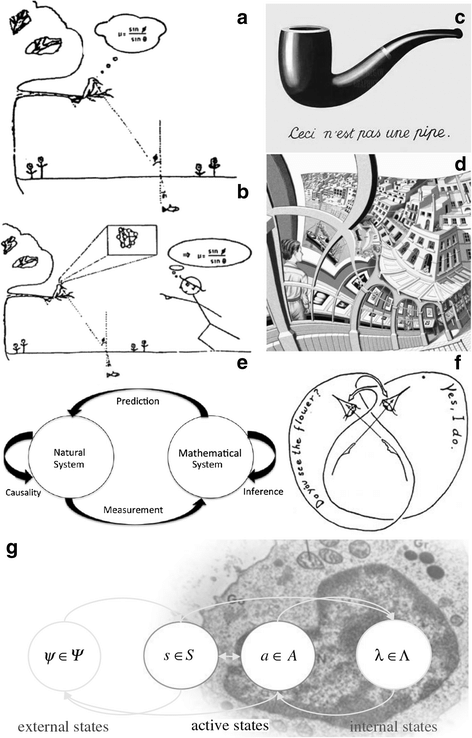If you don't understand Biosemiotics, don't worry—just check out this cartoon. You likely will end up even more puzzled, but at least you'll have a laugh.

Constructivist biosemiotics foundations. a, bPunch’s cartoon that show succinctly the cognitivist third-person hypothesis and the alternative one. a In the cognitivist third-person hypothesis, to catch his prey, for the observer, the kingfisher must represent in its brain the Snell’s refraction law by information processing. b The constructivist lecture show how the significance levels can be seen arising from the underlying structural network of the kingfisher and the model of the observer. c René Magritte’s painting (1928–29) pointing out the levels of realms in cognitive relations. A painted pipe is just an approximate map of a real pipe. d M.C. Escher’s Print Gallery lithograph showing how a young man is standing inside the same print as the one he is looking at. A constructivist interpretation in first-person indicates that what is observed is an active and enactive relation of the observer, depicting the complex closed loop of embodiment relations. e Rosen’s Modeling Relation shows that the observation of natural systems, governed by causal relations, is a cognitive act reflected in the relations of measurement and prediction subject to mathematical systems of inferential rules. If the mathematical system corresponds to the causal relations, then it can be assumed as a ‘Natural Law’. f Maturana draws how nervous system, though organizationally closed, use language to loop-through the other. g Minimization of free energy by active inference and prediction error indicates one possible formal representation of cognition and autopoiesis
"The process of message exchanges, or semiosis, is an indispensable characteristic of all terrestrial life forms. It is this capacity for containing, replicating, and expressing messages, of extracting their signification, that, in fact, distinguishes them more from the nonliving - except for human agents, such as computers or robots, that can be programmed to simulate communication - than any other traits often cited. The study of the twin processes of communication and signification can be regarded as ultimately a branch of the life science, or as belonging in large part to nature, in some part to culture, which is, of course, also a part of nature." (Sebeok 1991: 22)
"The life science and the sign science thus mutually imply one another." (Sebeok 1994: 114)
"Biosemiotics proper deals with sign processes in nature in all dimensions, including (1) the emergence of semiosis in nature, which may coincide with or anticipate the emergence of living cells; (2) the natural history of signs; (3) the 'horizontal' aspects of semiosis in the ontogeny of organisms, in plant and animal communication, and in inner sign functions in the immune and nervous systems; and (4) the semiotics of cognition and language. /../ Biosemiotics can be seen as a contribution to a general theory of evolution, involving a synthesis of different disciplines. It is a branch of general semiotics, but the existence of signs in its subject matter is not necessarily presupposed, insofar as the origin of semiosis in the universe is one of the riddles to be solved." (Emmeche 1992: 78)
"A modern unification of biology /../ has to be based on the fundamentally semiotic nature of life." (Hoffmeyer 1997)
"The most pronounced feature of organic evolution is not the creation of a multiplicity of amazing morphological structures, but the general expansion of 'semiotic freedom', that is to say the increase in richness or 'depth' of meaning that can be communicated" (Hoffmeyer 1996: 61).
"The sign rather than the molecule is the basic unit for studying life." (Hoffmeyer 1995: 369)
"Sign processes penetrate the entire body of an organism. [...] Signification is the fundamental property of living systems that can be taken as a definition of life. Hence, biosemiotics can be viewed as a root of both biology and semiotics rather than a branch of semiotics." (Sharov 1998: 404-405)
"Biosemiotics can be defined as the science of signs in living systems. A principal and distinctive characteristic of semiotic biology lays in the understanding that in living, entities do not interact like mechanical bodies, but rather as messages, the pieces of text. This means that the whole determinism is of another type. /../ The phenomena of recognition, memory, categorization, mimicry, learning, communication are thus among those of interest for biosemiotic research, together with the analysis of the application of the tools and notions of semiotics (text, translation, interpretation, semiosis, types of sign, meaning) in the biological realm." (Kull 1999: 386)
"With the discovery that a set of symbols has been used by nature to encode the information for the construction and maintenance of all living things, semiotics - the analysis of languages and texts as sets of signs and symbols - has become relevant to molecular biology. Semiotics has given students of the DNA text a new eye for reading, allowing us to argue for the validity of a multiplicity of meanings, or even for the absence of any meaning, in a stretch of the human genome." (Pollack 1994: 12)